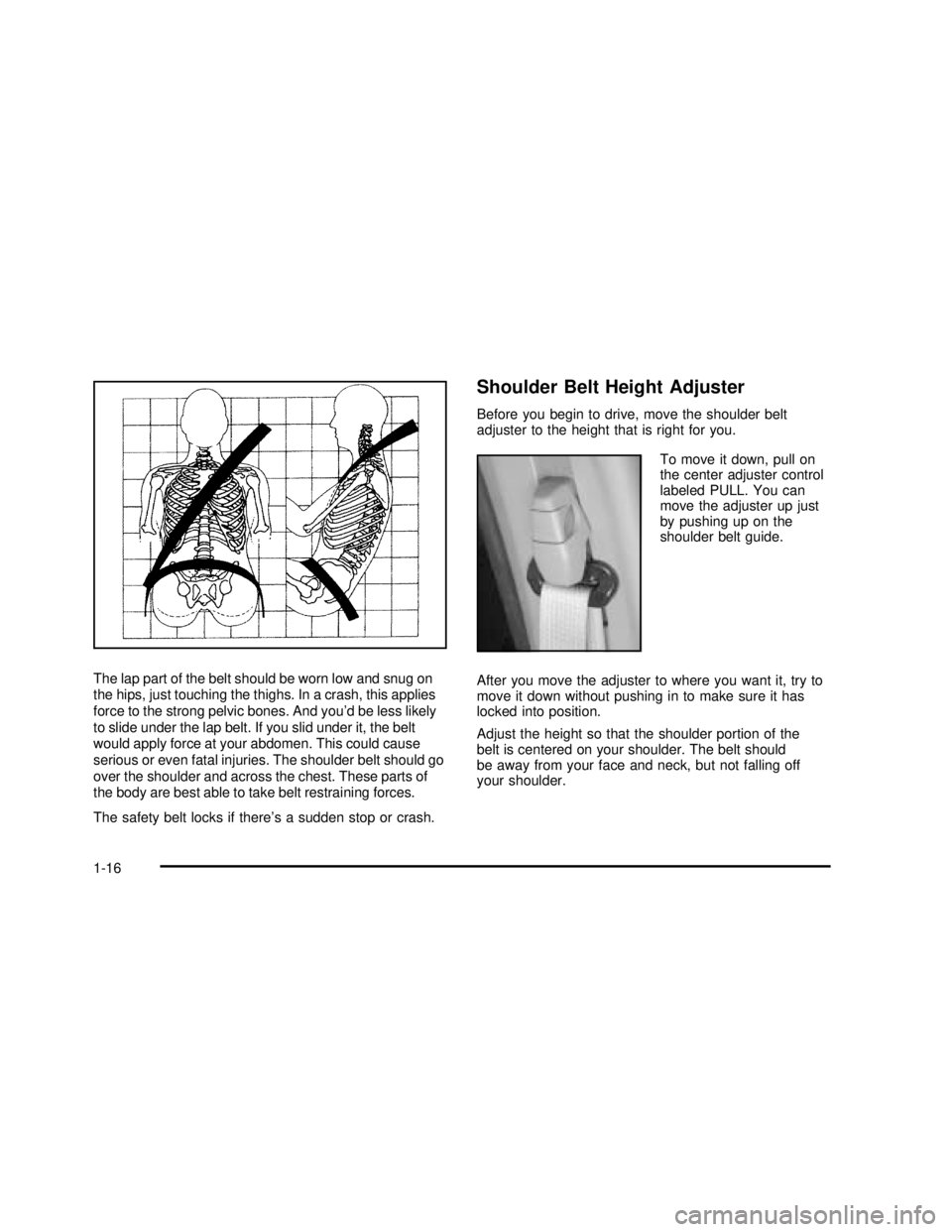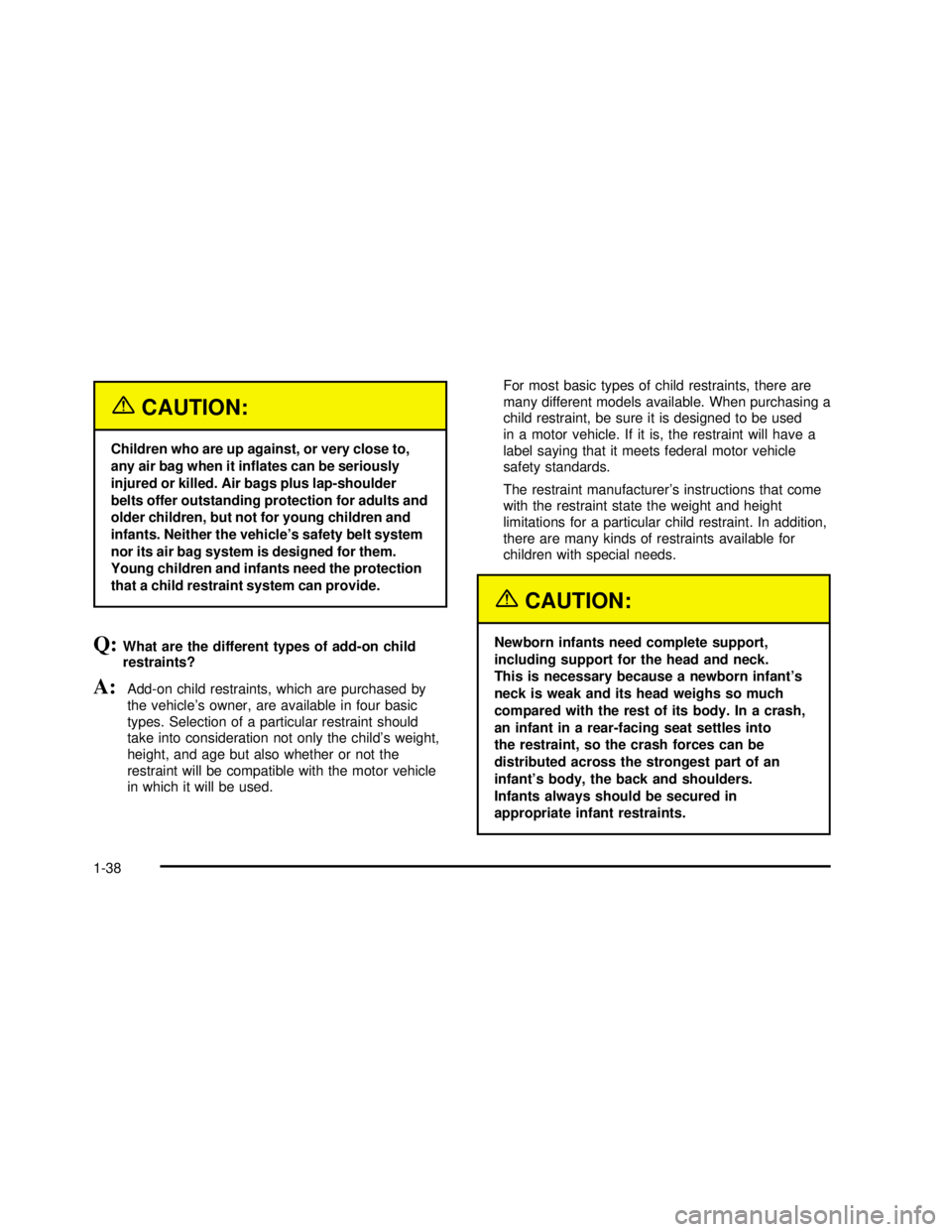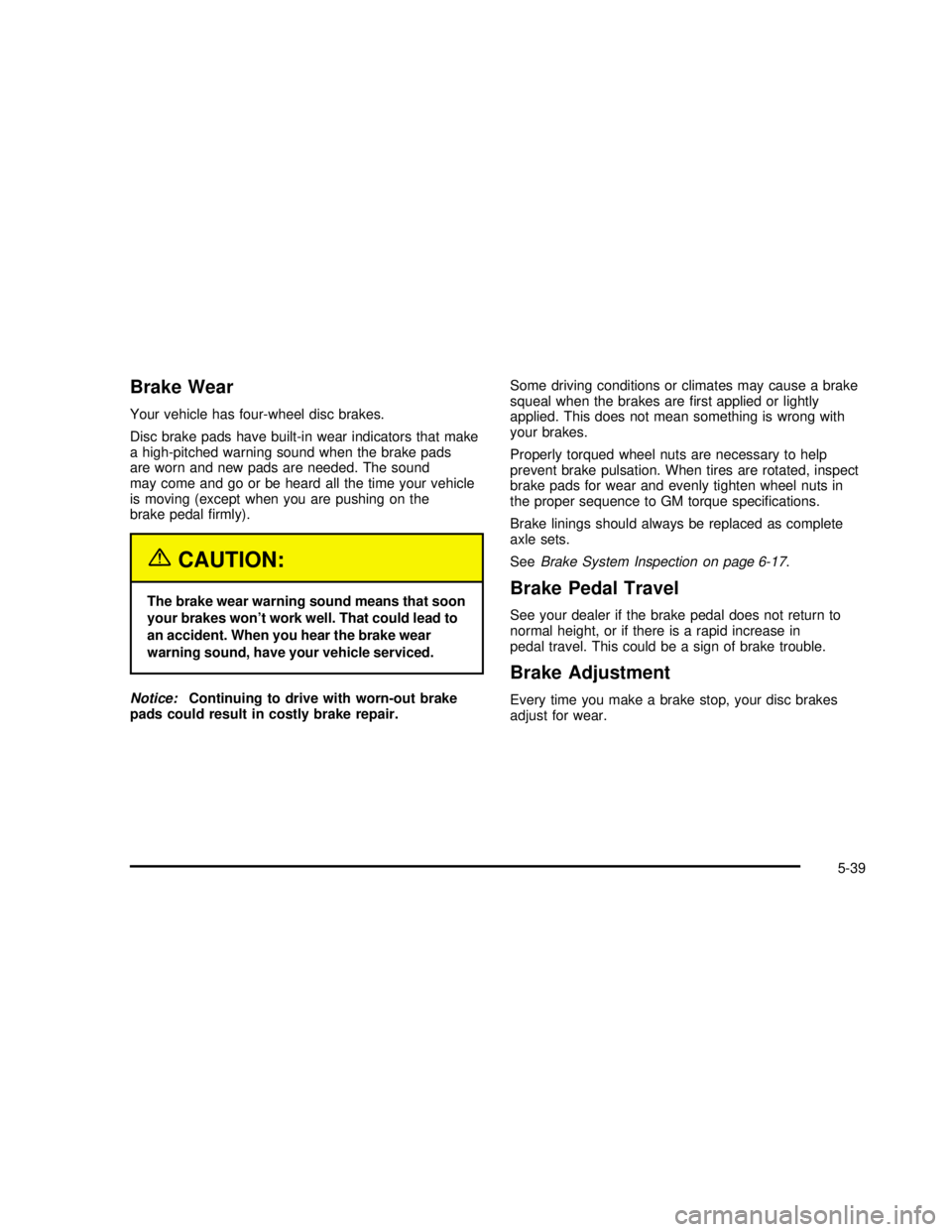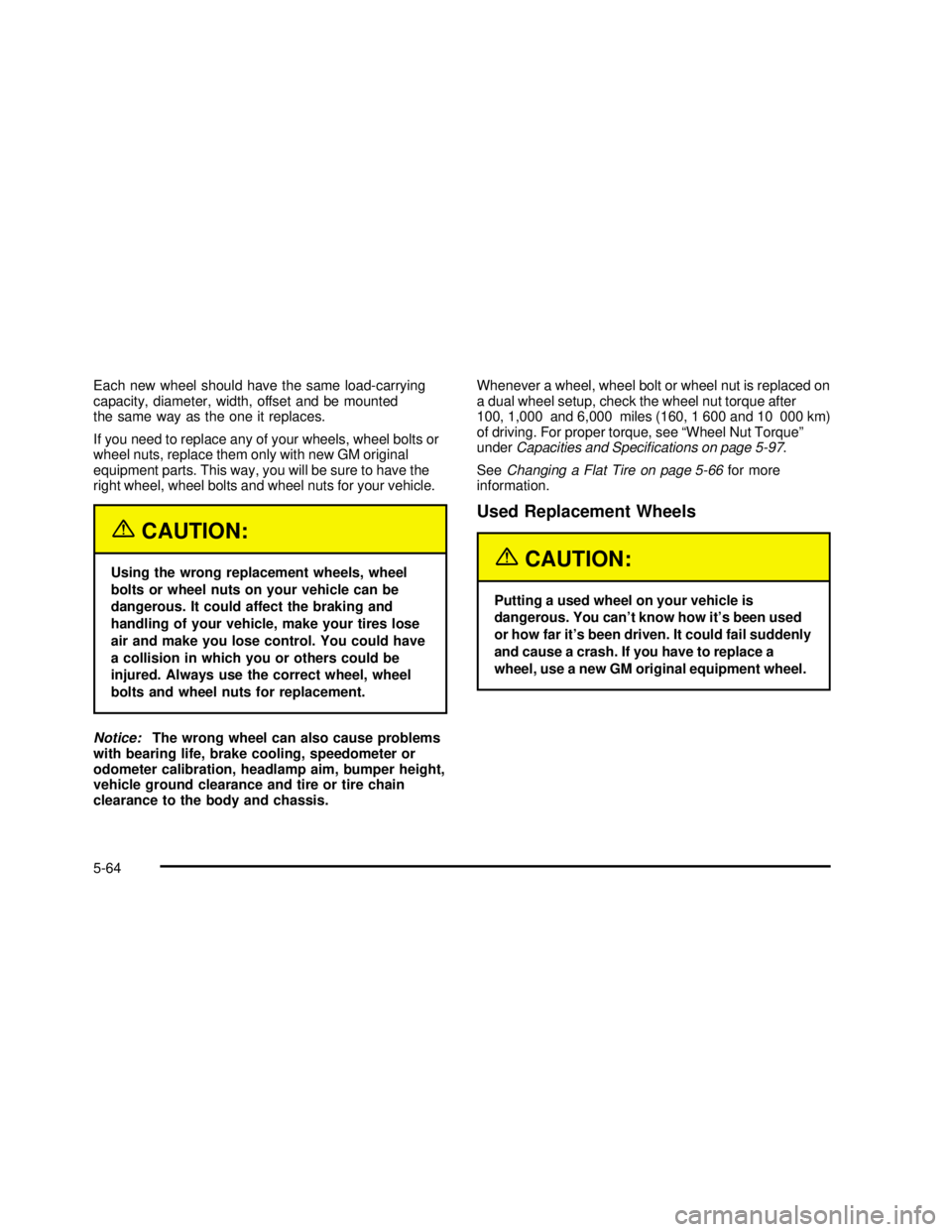height GMC SAVANA 2003 Owner's Manual
[x] Cancel search | Manufacturer: GMC, Model Year: 2003, Model line: SAVANA, Model: GMC SAVANA 2003Pages: 392, PDF Size: 2.34 MB
Page 22 of 392

The lap part of the belt should be worn low and snug on
the hips, just touching the thighs. In a crash, this applies
force to the strong pelvic bones. And youād be less likely
to slide under the lap belt. If you slid under it, the belt
would apply force at your abdomen. This could cause
serious or even fatal injuries. The shoulder belt should go
over the shoulder and across the chest. These parts of
the body are best able to take belt restraining forces.
The safety belt locks if thereās a sudden stop or crash.
Shoulder Belt Height Adjuster
Before you begin to drive, move the shoulder belt
adjuster to the height that is right for you.
To move it down, pull on
the center adjuster control
labeled PULL. You can
move the adjuster up just
by pushing up on the
shoulder belt guide.
After you move the adjuster to where you want it, try to
move it down without pushing in to make sure it has
locked into position.
Adjust the height so that the shoulder portion of the
belt is centered on your shoulder. The belt should
be away from your face and neck, but not falling off
your shoulder.
1-16
2003 - Savana OM
Page 44 of 392

{CAUTION:
Children who are up against, or very close to,
any air bag when it inļ¬ates can be seriously
injured or killed. Air bags plus lap-shoulder
belts offer outstanding protection for adults and
older children, but not for young children and
infants. Neither the vehicleās safety belt system
nor its air bag system is designed for them.
Young children and infants need the protection
that a child restraint system can provide.
Q:What are the different types of add-on child
restraints?
A:Add-on child restraints, which are purchased by
the vehicleās owner, are available in four basic
types. Selection of a particular restraint should
take into consideration not only the childās weight,
height, and age but also whether or not the
restraint will be compatible with the motor vehicle
in which it will be used.For most basic types of child restraints, there are
many different models available. When purchasing a
child restraint, be sure it is designed to be used
in a motor vehicle. If it is, the restraint will have a
label saying that it meets federal motor vehicle
safety standards.
The restraint manufacturerās instructions that come
with the restraint state the weight and height
limitations for a particular child restraint. In addition,
there are many kinds of restraints available for
children with special needs.
{CAUTION:
Newborn infants need complete support,
including support for the head and neck.
This is necessary because a newborn infantās
neck is weak and its head weighs so much
compared with the rest of its body. In a crash,
an infant in a rear-facing seat settles into
the restraint, so the crash forces can be
distributed across the strongest part of an
infantās body, the back and shoulders.
Infants always should be secured in
appropriate infant restraints.
1-38
2003 - Savana OM
Page 81 of 392

Adding Equipment to Your Air
Bag-Equipped Vehicle
Q:If I add a push bumper or a bicycle rack to the
front of my vehicle, will it keep the air bags
from working properly?
A:As long as the push bumper or bicycle rack is
attached to your vehicle so that the vehicleās
basic structure isnāt changed, itās not likely to keep
the air bags from working properly in a crash.
Q:Is there anything I might add to the front of
the vehicle that could keep the air bags from
working properly?
A:Yes. If you add things that change your vehicleās
frame, bumper system, front end sheet metal
or height, they may keep the air bag system from
working properly. Also, the air bag system may
not work properly if you relocate any of the
air bag sensors. If you have any questions about
this, you should contact Customer Assistance
before you modify your vehicle. The phone
numbers and addresses for Customer Assistance
are in Step Two of theCustomer Satisfaction
Procedure on page 7-2.
Restraint System Check
Checking Your Restraint Systems
Now and then, make sure the safety belt reminder light
and all your belts, buckles, latch plates, retractors
and anchorages are working properly. Look for any other
loose or damaged safety belt system parts. If you see
anything that might keep a safety belt system from doing
its job, have it repaired.
Torn or frayed safety belts may not protect you in a
crash. They can rip apart under impact forces. If a belt
is torn or frayed, get a new one right away.
Also look for any opened or broken air bag covers, and
have them repaired or replaced. (The air bag system
does not need regular maintenance.)
1-75
2003 - Savana OM
Page 279 of 392

Brake Wear
Your vehicle has four-wheel disc brakes.
Disc brake pads have built-in wear indicators that make
a high-pitched warning sound when the brake pads
are worn and new pads are needed. The sound
may come and go or be heard all the time your vehicle
is moving (except when you are pushing on the
brake pedalļ¬rmly).
{CAUTION:
The brake wear warning sound means that soon
your brakes wonāt work well. That could lead to
an accident. When you hear the brake wear
warning sound, have your vehicle serviced.
Notice:Continuing to drive with worn-out brake
pads could result in costly brake repair.Some driving conditions or climates may cause a brake
squeal when the brakes areļ¬rst applied or lightly
applied. This does not mean something is wrong with
your brakes.
Properly torqued wheel nuts are necessary to help
prevent brake pulsation. When tires are rotated, inspect
brake pads for wear and evenly tighten wheel nuts in
the proper sequence to GM torque speciļ¬cations.
Brake linings should always be replaced as complete
axle sets.
SeeBrake System Inspection on page 6-17.Brake Pedal Travel
See your dealer if the brake pedal does not return to
normal height, or if there is a rapid increase in
pedal travel. This could be a sign of brake trouble.
Brake Adjustment
Every time you make a brake stop, your disc brakes
adjust for wear.
5-39
2003 - Savana OM
Page 304 of 392

Each new wheel should have the same load-carrying
capacity, diameter, width, offset and be mounted
the same way as the one it replaces.
If you need to replace any of your wheels, wheel bolts or
wheel nuts, replace them only with new GM original
equipment parts. This way, you will be sure to have the
right wheel, wheel bolts and wheel nuts for your vehicle.
{CAUTION:
Using the wrong replacement wheels, wheel
bolts or wheel nuts on your vehicle can be
dangerous. It could affect the braking and
handling of your vehicle, make your tires lose
air and make you lose control. You could have
a collision in which you or others could be
injured. Always use the correct wheel, wheel
bolts and wheel nuts for replacement.
Notice:The wrong wheel can also cause problems
with bearing life, brake cooling, speedometer or
odometer calibration, headlamp aim, bumper height,
vehicle ground clearance and tire or tire chain
clearance to the body and chassis.Whenever a wheel, wheel bolt or wheel nut is replaced on
a dual wheel setup, check the wheel nut torque after
100, 1,000 and 6,000 miles (160, 1 600 and 10 000 km)
of driving. For proper torque, seeāWheel Nut Torqueā
underCapacities and Speciļ¬cations on page 5-97.
SeeChanging a Flat Tire on page 5-66for more
information.
Used Replacement Wheels
{CAUTION:
Putting a used wheel on your vehicle is
dangerous. You canāt know how itās been used
or how far itās been driven. It could fail suddenly
and cause a crash. If you have to replace a
wheel, use a new GM original equipment wheel.
5-64
2003 - Savana OM
Page 388 of 392

Setting the Time
Radios with Radio Data Systems (RDS)............3-41
Radios without Radio Data Systems (RDS)........3-41
Setting the Tone
(Bass/Treble)......................3-43, 3-46, 3-51, 3-62
Sheet Metal Damage.......................................5-87
Shifting Into Park (P).......................................2-27
Shifting Out of Park (P)...................................2-29
Shoulder Belt Height Adjuster...........................1-16
Single Stage Air Bags.....................................1-68
Skidding........................................................4-13
Sliding Side Door............................................2-11
Some Other Rainy Weather Tips.......................4-18
Spare Tire Check............................................6-13
Special Fabric Cleaning Problems.....................5-83
Speciļ¬cations, Capacities.................................5-97
Speedometer..................................................3-25
Starter Switch Check.......................................6-14
Starting Your Engine.......................................2-22
Steering.......................................................... 4-9
Steering and Suspension Inspection..................6-16
Steering in Emergencies..................................4-10
Steering Tips................................................... 4-9
Storage Areas................................................2-36
Storing a Flat or Spare Tire and Tools...............5-80
Stuck in Sand, Mud, Ice or Snow......................4-28Sun Visors.....................................................2-19
Swing-Out Side Door, 60/40.............................2-13
Swing-Out Windows........................................2-18
T
Taillamps.......................................................5-52
Tampering With Noise Control System
Prohibited...................................................5-49
Theft-Deterrent, Radio.....................................3-73
Theft-Deterrent Systems...................................2-19
Passlock
Ā®...................................................2-20
Throttle System Inspection...............................6-17
Tilt Wheel........................................................ 3-5
Tire Inļ¬ation Check.........................................6-12
Tires.....................................................5-56, 5-87
Buying New Tires........................................5-61
Chains.......................................................5-65
Changing a Flat Tire....................................5-66
Dual Tire Operation.....................................5-58
If a Tire Goes Flat.......................................5-65
Inļ¬ationāTire Pressure...............................5-57
Inspection and Rotation................................5-58
Uniform Tire Quality Grading.........................5-62
Wheel Alignment and Tire Balance.................5-63
Wheel Replacement.....................................5-63
When It Is Time for New Tires......................5-60
14
2003 - Savana OM